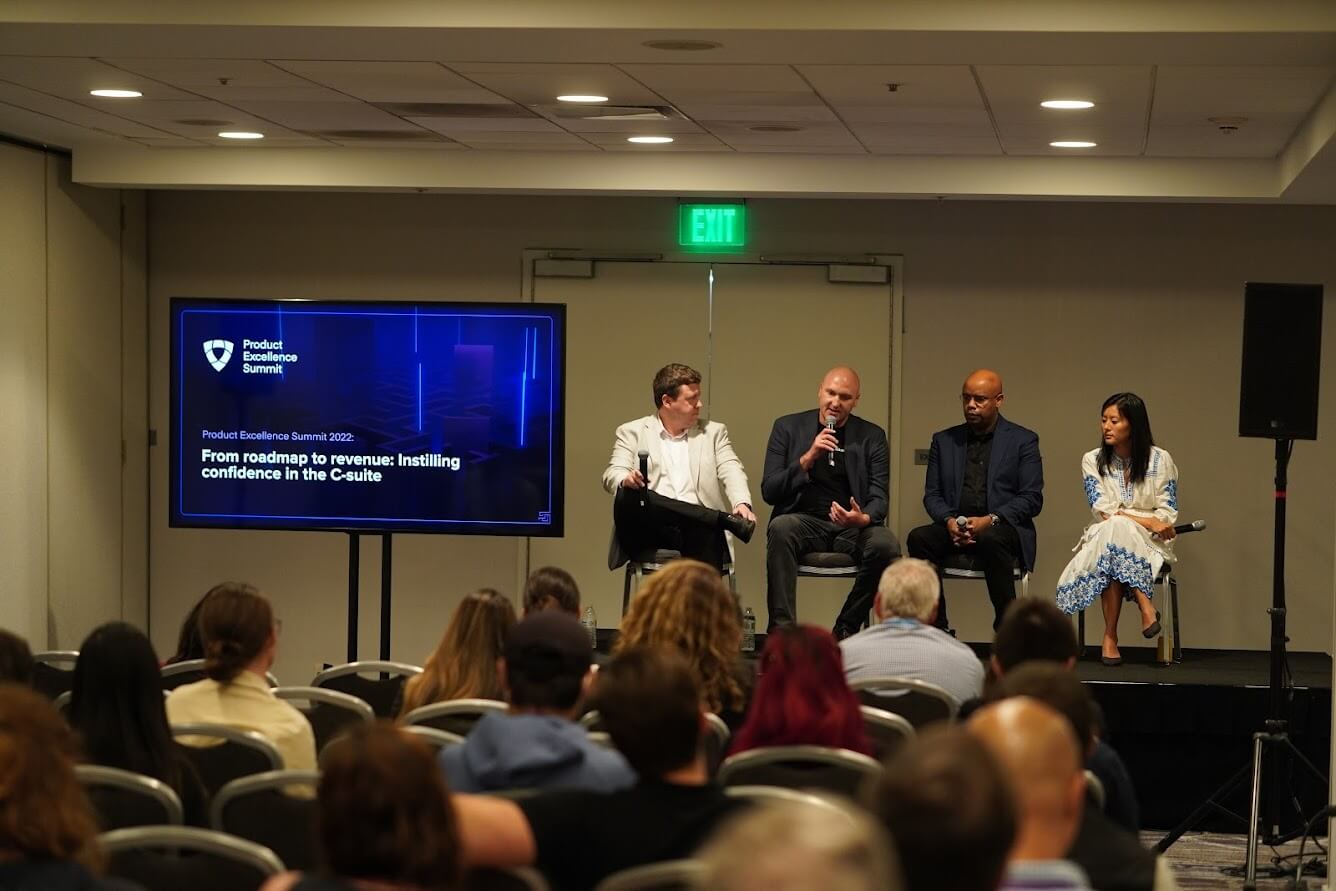4 ways product leaders can embrace uncertainty to uncover opportunity

While you can never completely cut the risks of uncertainty out of life, you can prepare for them and embrace the opportunity they provide. That was the premise of our 2022 Product Excellence Summit (now available on demand) and we wanted to be sure to share the best strategies for doing so with you, whether you were able to attend in-person, virtually, or only in spirit.
“Uncertainty is nothing new for Product people. Our job has always had uncertainty. We thrive in uncertainty,” Productboard CEO Hubert Palan said.
For product leaders, embracing uncertainty is all the more important to create a roadmap for success. Below, we share a few highlights from the summit to share with your team and across your organization.
Explore opportunities, but don’t let them detract from your core business
Opportunities can be exciting, but it’s the core business that really matters – and that can be easy to lose sight of when faced with a shiny new idea that could be just what the company needs in the face of precariousness.
Noah Singer, Director, Product Management at 1-800 Contacts, Nupur Kantamneni, VP of Product at Titan, John Stetic, Chief Product Officer at Prodigy Education, and Greg Strickland, COO at Productboard, discussed the lessons they’ve learned in driving product innovation during challenging times.
First things first: focus on what your core business users need right now.
“When we thought about the roadmap, we thought about what users need in this time.”
– Nupur Kantamneni, Titan
For the trio, that means you might have to ruthlessly prioritize what’s on your roadmap and say no to things if they ultimately aren’t right – because the customer didn’t love them enough, because you don’t have the resources right now, or because something no longer matches up with your business goals.
“Sometimes you have to make the tough decision to cut a new opportunity/product that some customers love, but not enough. You have to know when it’s time to get focused on the core product.”
– Noah Singer, 1-800 Contacts
Stetic talked about the role of team agency, and how that sense of control and responsibility is even more important during tough times.
“Anytime you need to navigate through challenging times, people want ownership over the problem and feel like they’ve overcome challenges as a team. Sometimes when times get tough, as leaders, we default to directives. You need to give direction, not directives.”
– John Stetic, Prodigy Education
Lay the groundwork for growth during the recession, so that you’re prepared when it ends
How do you reevaluate strategies in a time of change? Chris Craver, SVP, Head of Digital Products at Valley Bank, Ross Garrett, Head of Product at Volkswagen Automotive Cloud, Lakshmi Sharma, Chief Product & Strategy Officer at Fastly, and Srinivas Krishnamurti, SVP of Product, Productboard, all sat down to discuss exactly that.
It starts with being honest with your current resources, ruthlessly prioritizing customer needs and making sure that’s communicated across the organization – especially with key stakeholders. Success is never guaranteed, but it’s especially precarious when the macro environment is a finicky one.
“The vision at the outset and getting buy-in and agreement to that is important in the times when you’re successful and not successful.”
– Chris Craver, Valley Bank
Not to say that any of this is easy, especially if your organization is only recently working toward becoming a product-lead organization. Be prepared for the extra work that entails, both for you and for your team.
“The idea of being more focused on outcomes and to talk and sound like a product organization is a hard transformation for many businesses…this was a huge change for the rest of the team.”
– Ross Garrett, Volkswagen Automotive Cloud
How can you help that transition? Be clear, specific, and don’t be afraid to repeat yourself. Even if you feel like a broken record, for your audience it might be the first time a message really hits home, the panel said. The role of communication cannot be underscored either — be sure you’re doing so in every place that cross-functional team members may need visibility; just announcing it once in a company All-Hands isn’t enough.
“Be very transparent, communicate over and over what success will be.”
– Lakshmi Sharma, Fastly
The panel also noted that addressing pain points earnestly and honestly so you can move past them to gain progress toward key company goals is key to navigating challenges, all while keeping in mind what it is that you ultimately lose if you don’t meet them.
“What is the pain and what is that stopping you from gaining?”
– Srinivas Krishnamurti, Productboard
Think about both the present and future state when thinking about characteristics that you’re looking for
Building and scaling a high-performing product team is no easy feat and- like most things in life- there is no one-size-fits-all formula to follow. There are some common characteristics to look for in hiring the next generation of high performance product professionals, like a sense of grit and determination paired with an entrepreneurial bent – or a bit of a cowboy who wants to work someplace akin to the wild west.
That’s what Anique Drumright, Vice President, Product at Loom, and Ryan Kennedy, VP of Product at Pilot, shared in discussion with Productboard’s SVP of Marketing, Alicia Hale. And once you’ve built that team of “cowpersons” willing to work in the wild (possibly taming some Dangerous Animals along the way) you’ve got to scale them and lead them through uncertain times to discovery opportunities together. How?
“We’ve started to introduce this idea of global prioritization. Within my team, if there’s five things on the roadmap, I should know what order they’re in. I should know what I’m going to protect, and in some ways what I’m willing to sacrifice.”
– Anique Drumright, Loom
The other key is not hoarding information, but sharing it repeatedly in all the different ways it might be needed across the company, not just on the Product team.
“We’re trying to help create an environment that is high on indexing learning and high on indexing sharing…and build that shared context across teams.”
– Ryan Kennedy, Pilot
Think about the stage of your company when deciding which KPIs to focus on
If your C-Suite is filled with former product people, you’re incredibly lucky and you can probably skip this section. For everyone else, Productboard CFO Sebastien Giroux sat down with Jenny Decker, Chief Financial Officer at Front, Andrew “Drew” Wilson, CFO & COO at SoundCloud, and Stuart Wilson, Chief Revenue Officer at Weights and Biases, to discuss how to instill confidence in the C-Suite.
Making the connection from roadmap to revenue isn’t always easy and leadership often has to be carefully lead along the way, so that they in turn are able to convince investors and customers who see them as the face of the company.
“We’re selling the product as it is today and we’re selling the vision of who we are. And we’re asking the customer to invest in both.”
– Stuart Wilson, Weights and Biases
The ultimate goal of most product professionals, over time, is to hopefully get everyone around them also thinking like product people. That includes gaining a certain amount of technical know-how, including technical debt that lurks behind many seemingly simple features and products.
“Conversations to get the right assessment usually start with more revenue growth. But the real measurement, the currency of the conversation, is time and tech debt.”
– Andrew Wilson, SoundCloud
Time is the other key. It’s easy to be optimistic about how much you’ll have in the future when you finally hire that headcount or the team has been through a certain number of projects together. Be realistic instead, with yourselves and with leadership, on how your current team will achieve its goals.
“When you plan, and when you commit to OKRs, everyone is overly optimistic…commit to OKRs based on your existing headcount.”
– Jenny Decker, Front
Liked this and want to relive the summit or catch what you missed? Check out the full recordings below!




